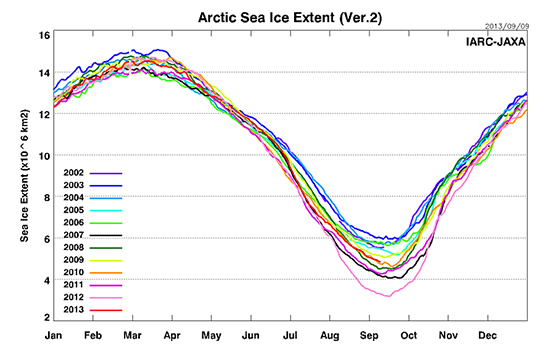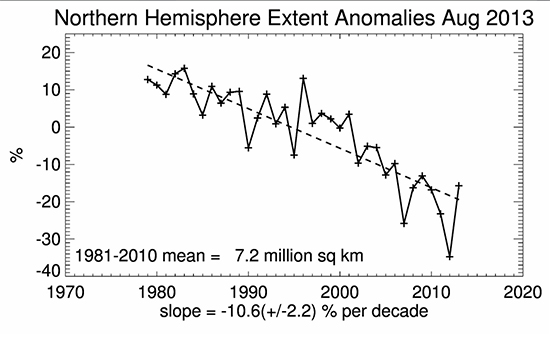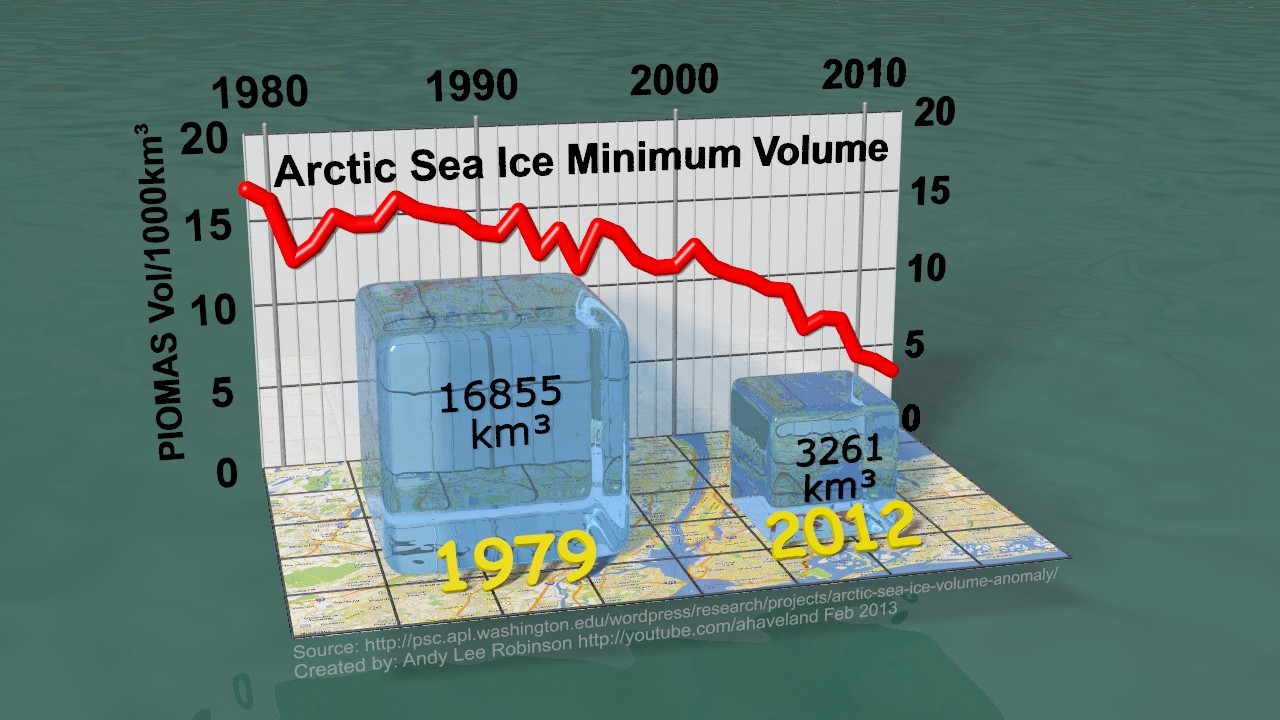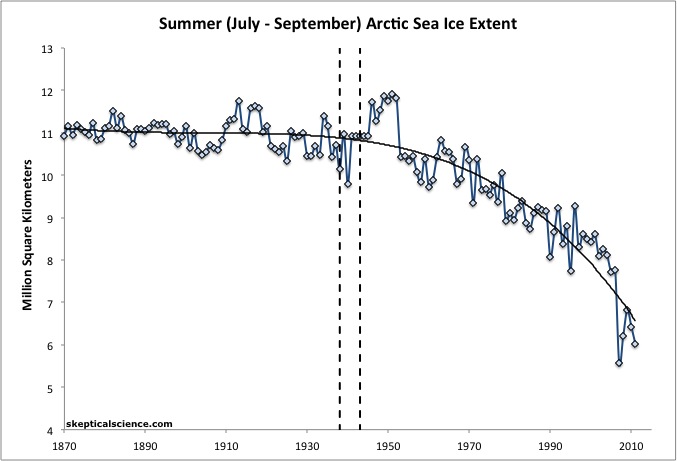
Manmade greenhouse gases are impeding the return of heat-energy to space and land, ice, water and air are taking in and/or exchanging that heat energy at different rates over time. That is the big picture of the global warming problem: we know there is a growing planetary energy imbalance and it is variously distributing itself as time goes by. Regular Skeptical Science readers might think that quite straightforward, but some others do not share that common sense. Thus the same old, long debunked myths pop up in the mainstream media again and again. Certain key dates seem to encourage this behaviour: the forthcoming IPCC's Fifth Assessment Report being a good example. Like the way a picnic on a sunny afternoon in August tends to attract lots of annoying wasps, major events on the climate change timeline tend to see certain contrarian figures and organisations dialling up the rhetorical output.
This is frustrating yet it has over the years become quite predictable: arguing with some climate change contrarians is similar to attempting debate with a well-trained parrot. Imagine: the parrot has memorised some twenty statements that it can squawk out at random. Thus it will follow up on 'no warming since 1997' with 'in the 1970s they said there'd be an ice-age' and so on. Another piece in the UK-based Daily Mail's Sunday edition of September 8th 2013, written by a figure familiar to Skeptical Science readers, Mail and Vanity Fair journalist David Rose, gives a classic example of such parroting. There's another in the UK's Daily Telegraph along remarkably similar lines (it could even be the same parrot), and Dana tackled both head-on in a Guardian article on September 9th. Here, we dissect the claims in more detail, free from the restrictions of media word-limits.
At Skeptical Science, we have previously pre-bunked and debunked and debunked again David Rose' articles on the subject of climate change, but he appears oblivious to legitimate criticism of his work. This time he pulls out all the stops. It's so bad that it's difficult to know where to start with this piece, but to begin at the beginning, as Dylan Thomas would have said, we have the headline. "Record return of Arctic ice cap as it grows by 60% in a year with top scientists warning of global COOLING", it squawks.
A casual reader, somebody not that familiar with the subject, might well interpret that and go away thinking that for the last twelve months, the Arctic 'ice-cap' has been getting bigger all the time. Let's clear a few things up. Firstly, it's the Arctic sea-ice that Rose is referring to, which is rarely if ever termed an ice-cap. Ice-caps are the elevated ice-sheets that sit atop of landmasses - such as Greenland and Antarctica - hence the word 'cap'. So to the Arctic sea-ice: we're not yet at the annual minimum that marks the climax of the melting-season, of course, but it is true that 2013 has not 'done a spectacular' in the way that 2012 did. Conditions in the Arctic have not favoured a massive melt-out this year: instead, the sea-ice extent decrease has behaved in a rather similar manner to the 2010 season and in recent weeks has followed almost the same course. Here are a couple of dataplots, first the extent from IARC-JAXA and then the anomaly compared to other years from the National Snow and Ice Data Center:


Both plots clearly show that 2013 has been a weak melting-season, compared to the phenomenal melts of 2007 and 2012. It was always unlikely that 2012 would be followed by a second record - there's too much noise around in the climate to make that likely. For the same reason that throwing two sixes with a pair of dice twice on two successive turns is rather unlikely (to put it mildly), fairly chaotic natural systems tend, most of the time, to trend towards the statistical mean. This is so frequently observed that it has a technical term: 'regression towards the mean'.
But Rose takes the following seasonal cycle (September 7th data were the last figures he could have used before the piece was published) and applies an unique spin to it (numerical data from IARC-JAXA):
2012: maximum extent reached: 7th March; value: 14,709,086 km2
2012 7th Sept extent: 3,312,446 km2
2013: maximum extent reached: 14th March; value: 14,523,635 km2
2013 7th Sept extent: 4,893,380 km2
From 14.7 million square kilometres it melts down to 3.31 in 2012, it then grows back to 14.52 at its winter maximum (less than winter 2012) and then melts down to 4.89 as of September 7th 2013. Rose then triumphantly states in one year the ice grew by 60%. This is misleading: sea-ice growth occurs over an approximately six-month period beginning every autumn, when the sea starts to freeze and the ice extent expands from its minimum value. When the ice is retreating during the six-month melting-season, it is not growing, no matter whether one year's minimum reveals less melt than the previous year's. Consider: if one man in a bar takes four swigs from his pint of beer and another takes three swigs, is the latter's pint glass magically refilling itself? The piece includes a pair of satellite images of the sea-ice in 2012 and 2013, emblazoned with the caption:
HOW ICE-SHEET GREW 920,000 SQUARE MILES IN A YEAR
Using the above analogy, one might well say:
MIRACLE! FROM PINT HALF-EMPTY TO PINT HALF-FULL IN MINUTES!
All this talk of growth and recovery brings to mind the following graph, which shows this type of spinning for what it really is:
If you are going to play David Rose' game here, there were clearly 'recoveries', involving 'growth', in 2006, 2008 and 2009, too. And just look at 1996! Hell of a 'growing season', there...
But, since climate is noisy on short-term timescales, so that decadal and multidecadal trends help us to see the wood for the trees, let's look, from the same numerical data source, at decadal averages for September 7th:
1980s: 7,255,232
1990s: 6,550,737
2000s: 5,537,967
These figures speak for themselves, in a very definite downwards fashion. Furthermore, it is worth remembering that Arctic sea-ice has lost around 75% of its volume in the past thirty years, dramatically illustrated in this graphic by Andy Lee Robinson (for alternate animated depictions of the volume data by Andy, click here or here):

Rose then goes on a bit of a BBC-bashing spree, a popular pastime at the Mail. He cites a December 2007 report on the BBC News website, writing:
The BBC’s 2007 report quoted scientist Professor Wieslaw Maslowski, who based his views on super-computer models and the fact that ‘we use a high-resolution regional model for the Arctic Ocean and sea ice’. He was confident his results were ‘much more realistic’ than other projections, which ‘underestimate the amount of heat delivered to the sea ice’. Also quoted was Cambridge University expert Professor Peter Wadhams. He backed Professor Maslowski, saying his model was ‘more efficient’ than others because it ‘takes account of processes that happen internally in the ice’. He added: ‘This is not a cycle; not just a fluctuation. In the end, it will all just melt away quite suddenly.’
Oddly, some might think, Rose left out another part of the same BBC piece: I wonder why?
The US National Snow and Ice Data Center (NSIDC) collects the observational data on the extent of Arctic sea ice, delivering regular status bulletins. Its research scientist Dr Mark Serreze was asked to give one of the main lectures here at this year's AGU Fall Meeting. Discussing the possibility for an open Arctic ocean in summer months, he told the meeting: "A few years ago, even I was thinking 2050, 2070, out beyond the year 2100, because that's what our models were telling us. But as we've seen, the models aren't fast enough right now; we are losing ice at a much more rapid rate. "My thinking on this is that 2030 is not an unreasonable date to be thinking of." And later, to the BBC, Dr Serreze added: "I think Wieslaw is probably a little aggressive in his projections, simply because the luck of the draw means natural variability can kick in to give you a few years in which the ice loss is a little less than you've had in previous years. But Wieslaw is a smart guy and it would not surprise me if his projections came out."
That seems, to me at least, quite balanced (the BBC piece, I mean). One scientist makes a prediction and whilst another does not rule it out entirely, he suggests that it is an unlikely scenario. But through the cherrypicking eyes of David Rose, the predictions were made by the BBC:
"THERE WON'T BE ANY ICE AT ALL! HOW THE BBC PREDICTED CHAOS IN 2007"
Hmmm... and there was me thinking it was a broadcasting organisation - I never realised they did climate predictions too. They don't, of course.
There are plenty more squawks to deal with, and the next one is an absolute classic:
The continuing furore caused by The Mail on Sunday’s revelations – which will now be amplified by the return of the Arctic ice sheet – has forced the UN’s climate change body to hold a crisis meeting. The UN Intergovernmental Panel on Climate Change (IPCC) was due in October to start publishing its Fifth Assessment Report – a huge three-volume study issued every six or seven years. It will now hold a pre-summit in Stockholm later this month.
Just what 'crisis meeting' is being referred to here? Well, the IPCC's website sets out the timetable and procedure for reviewing the forthcoming Fifth Assessment Report (AR5):
Step 1: First Review (by Experts)
Step 2: Second Review (by Governments and Experts)
Step 3: Government Review of Final Draft SPM
Step 4: Approval/Acceptance of SPMs and Working Group Reports
Under step 4, the sub-timetable is as follows:
For each Working Group report, the full reports will be accepted at the Working Group Session and their SPMs approved by IPCC member governments at the Working Group Session and then accepted at a Session of the Panel. These will take place as follows:
WG I 23-26 September 2013, Stockholm, Sweden
WG II 25-29 March 2014, Yokohama, Japan
WG III 7-11 April 2014, Berlin, Germany
The dates for these meetings were set in 2009, as can be seen via the timetable, dated Novermber 3rd of that year, here (PDF). So there's your 'crisis meeting'. Working Group One's session, scheduled four years ago, for acceptance of its report. Edit: also see the update, directly from the IPCC, at the bottom of this post (added 11/09/2013).
Anyone can make mistakes, of course, but the benefit of the doubt can be wholly withdrawn in this instance: in a tweet by Dr Ed Hawkins, who found himself at the centre of a bit of Rose-generated controversy last March (the Mail ended up having to apologise to him), he said:
"Yes - I told David Rose on the phone and by email on Thursday about the IPCC process and lack of 'crisis' meeting."
So Rose knew all along, yet he still went ahead to dress it up as something else altogether. Why, David? But onwards again: he's now onto a new theme - 'global cooling'.
Some eminent scientists now believe the world is heading for a period of cooling that will not end until the middle of this century – a process that would expose computer forecasts of imminent catastrophic warming as dangerously misleading. The disclosure comes 11 months after The Mail on Sunday triggered intense political and scientific debate by revealing that global warming has ‘paused’ since the beginning of 1997 – an event that the computer models used by climate experts failed to predict.
Ah, great excuse to get the ice-age theme - a minority view at the time - in somewhere! Curry's - well - just being Curry: making contrarian noises that are sufficiently vague that it's difficult to know how to interpret them: stating the models are too sensitive to carbon dioxide, for example, is meaningless without a 'because' afterwards followed by a clearly-set out explanation as to why she thinks this is the case. The latter bit always seems to be absent.
Rose then goes on to cite Anastasios Tsonis, of the University of Wisconsin:
‘We are already in a cooling trend, which I think will continue for the next 15 years at least. There is no doubt the warming of the 1980s and 1990s has stopped. ‘The IPCC claims its models show a pause of 15 years can be expected. But that means that after only a very few years more, they will have to admit they are wrong.’
When you cite somebody, it is good manners to repeat what they said, not distort it. I emailed Tsonis to check whether he really said that the IPCC has climate models (they don't). He replied:
You are right. It should not be "its models" it should just be "models"
Thought as much. However, I went on to ask:
While we're in touch, for how long do you see this pause in surface air temperature rise to continue, and once the pause has come to its close, do you expect a strong warming signal to once again emerge?
The response was:
As I mentioned in the interview our projection is for another 10-15 years of slight cooling. After that I cannot say. Not yet at least.
OK, several things stand out here. Firstly, it is a projection, and at that, an outlier among many, most of which run out to the end of the century and only differ in how much warmer it's going to be. The Tsonis projection, however, takes us only to the period 2023-2028 (this is what Rose calls the 'middle of the century', by the way), beyond which he 'cannot say'. We covered the research by Tsonis and colleagues, work that has regularly been misrepresented by climate contrarians over the years, here. Conventional understanding for the switch from flatlining temperatures or even slight cooling to a strong warming signal in the 1970s is that warming from anthropogenic carbon dioxide overcame the cooling influence from forcing agents such as sulfate aerosols. Tsonis and colleagues have suggested an alternative hypothesis involving ocean cycles such as the El Nino Southern Oscillation and the North Atlantic Oscillation in which the cycles synchronised at certain moments after which the climate seemed to shift to a new regime, which, they stated, may be superimposed on an anthropogenic warming trend. Here's their 2009 paper in PNAS (PDF), for anybody who wants to read up on the topic.
It is also necessary to consider again that such projections deal only with near-surface air temperatures and that climate change does not just involve the atmosphere, but the land itself, the rivers, lakes and oceans and the ice of the cryosphere. All are capable of accumulating, transporting and exchanging heat energy.
The piece then goes on to mention the aforementioned Dr Ed Hawkins, who agreed that natural variability may have contributed to some of the recorded warming, but that it could not, on its own, explain the upward temperature trend of the last 150 years. The one voice of reason in the entire piece, in other words.
The article ends with yet another silly and oft-touted claim (don't these guys have anything better to do?):
Yet there is mounting evidence that Arctic ice levels are cyclical. Data uncovered by climate historians show that there was a massive melt in the 1920s and 1930s, followed by intense re-freezes that ended only in 1979 – the year the IPCC says that shrinking began.
This appears to be a variation on a theme from John Christy who has made claims about low minima in the late 1930s-early 1940s (the lowest minimum, in 1940, was in fact approximately 9.8 million square kilometres - as opposed to less than 3.4 million square kilometres in 2012, or 4.89 at the moment). Skeptical Science has examined these claims before - here, for example. One of the most widely used long-term estimates of Arctic sea ice extent comes from Walsh and Chapman (2001), whose data are available from the University of Illinois. The following graph shows what the sea-ice looked like in the 1930s and 40s; it does show that there was a grouping of strong melt-seasons at the end of the 30s but it also demonstrates, in relative terms, how they compare to modern times:

Above: average July through September Arctic sea ice extent 1870-2008 from the University of Illinois (Walsh & Chapman 2001 updated to 2008) with observational data from NSIDC for 2009-2011 (both in blue), with a fourth order polynomial fit (black soiid line). Black vertical dashed lines indicate the years 1938-43.
So, in that single piece, David Rose has managed to present an ice-melt of 14,523,635 km2 down to 4,893,380 km2 as "growth": he has presented a skewed account of a balanced BBC article from 2007 and misrepresented it as something the "BBC predicted", he has knowingly misrepresented a very mundane and long-planned part of the IPCC's work-schedule, he has placed spin and distortion on Tsonis' work and thrown in a whole heap of long-debunked myths to boot. That's going some!
Final memo to David: yes, we in the climate community know that natural variability can exascerbate or alternatively mask the warming trend due to anthropogenic greenhouse gas emissions and that such variability is particularly important on short timescales. We call it 'noise' against the manmade global warming signal, something which two centuries' worth of climate science has steadily consolidated. Thus, you'll get a record Arctic sea-ice low one year, followed by a few less spectacular seasons, followed by another record. The overall trend is downwards, though, nevertheless. It matters not how much you huff and puff. Likewise, you might get twenty or even thirty years in which La Nina is the dominant ENSO phase, transferring phenomenal amounts of heat energy into the deep oceans yet affecting air temperatures to give the false impression that warming has slowed down - based on measurements of only one part of Earth's climate system whilst ignoring the rest. Spin and distort as much as you like, there's one thing that will never take any notice of you, and that's the laws of physics.
GENEVA, 11 September - In response to recent articles about forthcoming meetings of the Intergovernmental Panel on Climate Change, the IPCC would like to note that:
Contrary to the articles the IPCC is not holding any crisis meeting. The IPCC will convene a plenary session to finalize the Working Group I contribution to the IPCC's Fifth Assessment Report, in line with its normal procedures, in Stockholm on 23-26 September 2013. The session has been scheduled for several years and this timetable has been repeatedly publicized by the IPCC.
As part of the IPCC's regular procedures, member governments were invited to comment on the final draft of the Summary for Policymakers of the Working Group I report ahead of the Stockholm meeting. Over 1,800 comments were received - a typical number for this exercise - and they will be considered as planned at the meeting in Stockholm. The Summary for Policymakers is due to be released on 27 September 2013. The accepted Final Draft of the full Working Group I report, comprising the Technical Summary, 14 Chapters and three Annexes, will also be released online in unedited form, on Monday 30 September. Following copy-editing, layout, final checks for errors the full Working Group I report “Climate Change 2013: The Physical Science Basis”, and its Summary for Policymakers will be published online in January 2014 (tbc) and in book form by Cambridge University Press a few months later.
Source: http://www.ipcc.ch/pdf/press-releases/pr_11Sep2013_statement.pdf
I see the Mail article has been extensively rehashed, with the update timestamp being the evening of September 28th (it's still at the same URL) with the 'IPCC crisis meeting' claim removed and some revised ice 'growth' figures (now it's 'grown' by 29% not 60%). The Tsonis misquote about the IPCC having climate models is still in there, plus plenty of other nonsense including the 1920s-1930s claim. Expect more of the same in other words - and when it arrives we'll be waiting!
Posted by John Mason on Tuesday, 10 September, 2013
 |
The Skeptical Science website by Skeptical Science is licensed under a Creative Commons Attribution 3.0 Unported License. |